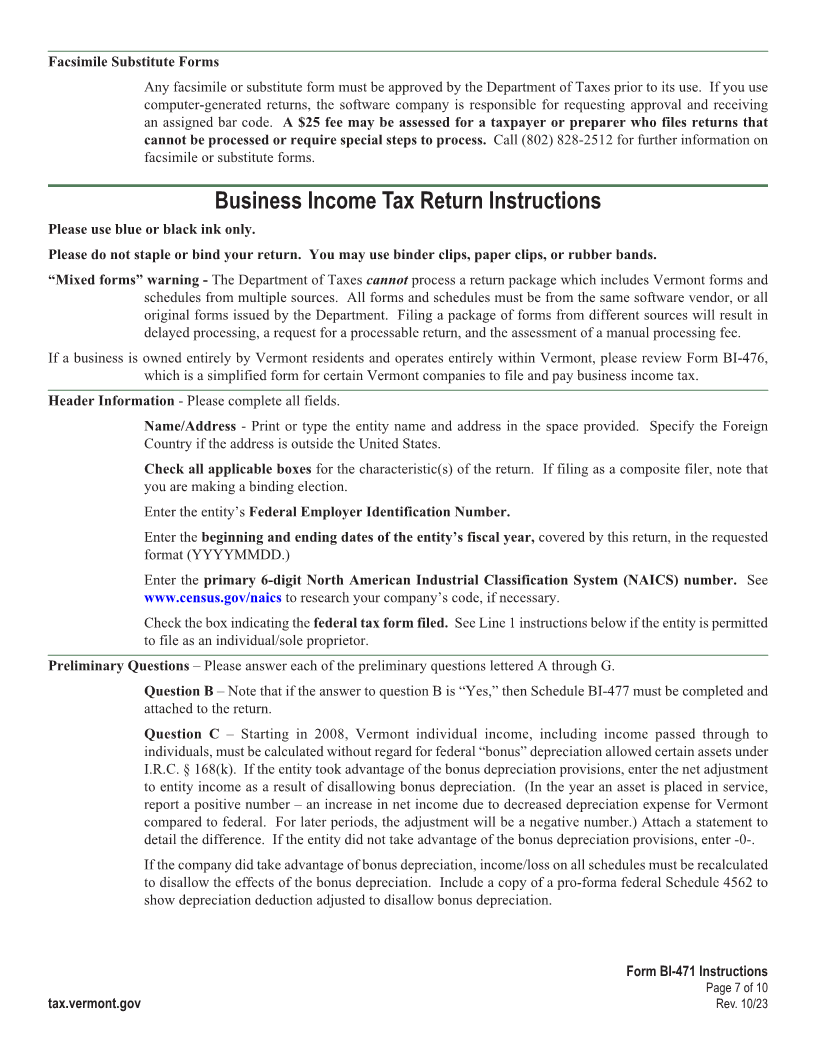
Enlarge image
FORM BI-471 Instructions
Business Income Tax Return
(For Subchapter S Corporations, Partnerships, and Limited Liability Companies) Page 1
Please print in BLUE or BLACK ink only.
New for 2023
The Business Income Tax Return package, Form BI-471 and related schedules – These forms have been substantially
reworked to improve administration, efficiency, and accountability for taxpayers (business income and
individual income) and the Vermont Department of Taxes.
• Effective for years starting on or after Jan. 1, 2023, taxpayers will use the new Schedule BI-477 to
determine sourcing of income and Vermont income adjustment.
○ – is no longer used with Schedule BA-402 Vermont – Apportionment and Allocation
Form BI-471
○ This change aligns the income calculation with:
INSTR (Place at FIRST page)
◙ information available on federal schedules, and Instr. pages
◙ Vermont’s method for income adjustment as defined in individual income tax statutes.
• Schedules BI-472 and BI-473 are streamlined.
• Schedule K-1VT is expanded to include information that will help shareholders, partners, and members
file accurate income tax returns. 1 - 10
• Most underlying statutes have not changed. Nevertheless, business income is now apportioned using a
single sales factor rather than three factor apportionment.
Reminders and additional information for 2023
The Commissioner of Taxes has mandated the electronic filing of Vermont Corporate Income, Business
Income, and Fiduciary Income Taxes beginning with the 2015 tax year, effective Jan. 1, 2016. This
mandate applies to tax practitioners who prepare more than 25 tax returns per year. The Director of the
Division of Taxpayer Services will consider a written request for an exemption based on extraordinary
circumstances.
Composite filing requirements – Composite filing is mandatory for entities that have more than 50
shareholders, partners, or members who are not residents of Vermont. Entities filing composite returns must
include all such nonresident shareholders, partners, or members in the composite filing. “Partial composite”
returns will not be accepted.
We expect to match entries on your Vermont return with entries on your federal return. If an entry on your
Vermont return differs from the expected entry, you must include an explanation and reconciliation. If you
do not provide supporting information, then we may adjust your return based on the available information.
Schedule K-1VT and disregarded entities: Vermont Schedule K-1VT has extended instructions for a
“disregarded entity” that does not file a Vermont income tax return. Please review the Schedule K-1VT
instructions “Notes for disregarded entities.” If Schedule K-1VT is not properly completed, or if required
supporting information is not included, then processing of your return is subject to delays.
TCJA: Tax Cut and Jobs Act of 2017 “TCJA” Conformity. Details are provided on our website
www.tax.vermont.gov. Provisions of the TCJA may affect how you prepare your Vermont income tax
return. Search for “TCJA” on our website www.tax.vermont.gov for detailed information.
Form BI-471 Instructions
Page 1 of 10
tax.vermont.gov Rev. 10/23








